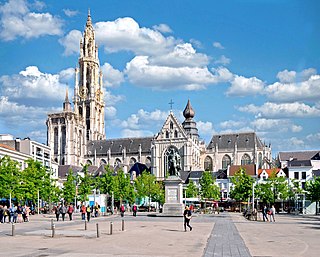
The Cathedral of Our Lady is a Roman Catholic cathedral in Antwerp, Belgium. Today's seat of the Diocese of Antwerp started in 1352 and, although the first stage of construction was ended in 1521, has never been 'completed'. It was constructed in the Gothic style by architects Jan and Pieter Appelmans. It contains a number of significant works by the Baroque painter Peter Paul Rubens, as well as paintings by artists such as Otto van Veen, Jacob de Backer and Marten de Vos. The cathedral is the largest Gothic church in Belgium, with its tower rising 123 meters over the city.
The States of Brabant were the representation of the three estates to the court of the Duke of Brabant. The three estates were also called the States. Supported by the economic strength of the cities Antwerp, Brussels and Leuven, the States always were an important power before the rulers of the country, as was reflected by the charter of the duchy.

St. James' Church is a former collegiate church in Antwerp, Belgium. The church is built on the site of a hostel for pilgrims to Santiago de Compostela. The present building is the work of the Waghemakere family and Rombout Keldermans, in Brabantine Gothic style. The church contains the grave of Peter Paul Rubens in the eastern chapel.

Averbode Abbey is a Premonstratensian abbey situated in Averbode, in the municipality Scherpenheuvel-Zichem, in the Archdiocese of Mechelen-Brussels in Belgium. It was founded about 1134, suppressed in 1797, and reestablished in 1834. Throughout the 20th century the abbey press was a leading children's publisher in Belgium. The church's building is a peculiar synthesis of Baroque and Gothic, with Renaissance ornament details, dominating the monastery complex. The whole structure was built of iron sandstone from Langdorp and white sandstone from Gobertange between 1664 and 1672, after a design by the Antwerp architect Jan Van den Eynde II.

Jacob Foppens van Es, Jacob Fopsen van Es or Jacob van Es was a Flemish Baroque painter known for his still lifes mainly of food and occasionally flower paintings. He collaborated with other artists on garland paintings. Together with Osias Beert and Clara Peeters, he was one of the leading representatives of the first generation in Flemish still-life painting.

Isabella Brant was the first wife of the Flemish baroque painter Peter Paul Rubens, who painted several portraits of her.
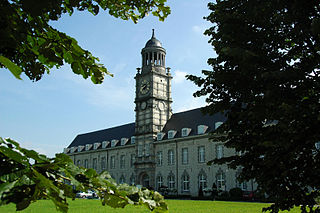
St. Bernard's Abbey, Hemiksem, or abbatiae S. Bernardi ad Scaldim, ordinis Cisterciensis, in dioecesi Antverpiensi also known as St. Bernard's Abbey on the Scheldt, located in Hemiksem in the province of Antwerp in Belgium, was a Cistercian monastery founded in 1243 and dissolved during the French Revolution. The buildings are now the property of the municipality of Hemiksem.

The Diocese of Antwerp is a Latin Church ecclesiastical territory or diocese of the Catholic Church in Belgium. The diocese was restored in 1961. It is a suffragan in the ecclesiastical province of the metropolitan Archdiocese of Mechelen-Brussels. Its cathedra is found within the Cathedral of Our Lady.
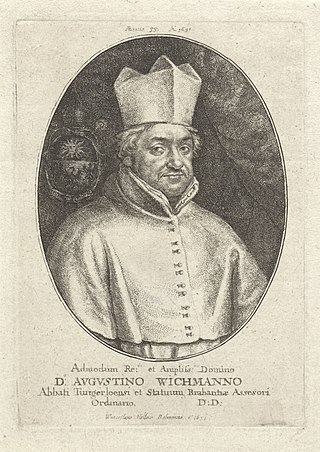
Francis Wichmans (1596–1661), in religion Augustinus, was a Premonstratensian spiritual author, missionary, and abbot of Tongerlo Abbey. In the last capacity he sat in the First Estate of the States of Brabant.

HelenaFourment was the second wife of Baroque painter Peter Paul Rubens. She sat for a few portraits by Rubens, and also modeled for figures in Rubens' religious and mythological paintings.
Jean François Foppens, sometimes Latinized Johannes Franciscus Foppens (1689–1761), was a Belgian ecclesiastical historian, and literary biographer and bibliographer. He is best known for his Bibliotheca belgica, sive virorum in Belgio vita scriptisque illustrium catalogus, a catalogue of Belgian authors and their works.

Johannes Chrysostomus vander Sterre (1591–1652), sometimes Jean Chrysostome Van der Sterre or Joannes Chrysostomus Stella, was an ecclesiastical writer and abbot of St. Michael's Abbey, Antwerp.
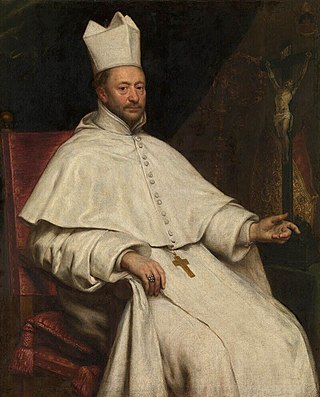
Katharina Pepijn or Catharina Pepijn was a Flemish painter who was known for her history paintings and portraits.
Events from the 1590s in the Spanish Netherlands and Prince-bishopric of Liège.
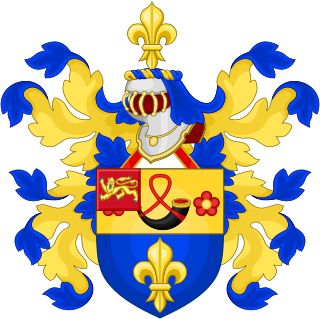
The Rubens family is a Flemish noble family that lived in Antwerp.

Nicolaas Peter Paul Rubens, Lord of Rameyen (1618–1655) was a son of the painter Peter Paul Rubens and Isabella Brant.

Pleurants or weepers are anonymous sculpted figures representing mourners, used to decorate elaborate tomb monuments, mostly in the late Middle Ages in Western Europe. Typically they are relatively small, and a group were placed around the sides of a raised tomb monument, perhaps interspersed with armorial decoration, or carrying shields with this. They may be in relief or free-standing. In English usage the term "weepers" is sometimes extended to cover the small figures of the deceased's children often seen kneeling underneath the tomb effigy in Tudor tomb monuments.

Joannes Chrysostomus Teniers, the religious name of Joannes Jacobus Teniers, also known as Jan Jacob or Jean-Jacques Teniers (1653–1709) was a Flemish preacher and poet. He was the abbot of the St. Michael's Abbey in Antwerp and in that capacity also the Lord of Berendrecht and Santvliet.

Norbertus van Couwerven was the 43rd abbot of St. Michael's Abbey, Antwerp.

Macarius Simeomo or Simeomus, born Jean-Baptiste (1616–1676) was the 44th abbot of St. Michael's Abbey, Antwerp.


















